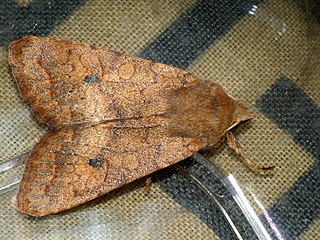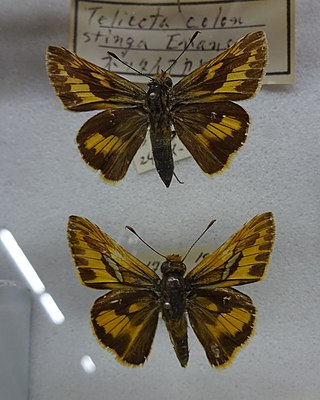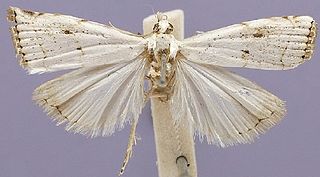
Agrochola circellaris, or The Brick, is a species of moth of the family Noctuidae. The species was first described by Johann Siegfried Hufnagel in 1766. It is distributed throughout most of Europe, Asia Minor and Armenia.

The angle shades is a moth of the family Noctuidae. The species was first described by Carl Linnaeus in his 1758 10th edition of Systema Naturae. It is distributed throughout Europe as far east as the Urals and also in the Azores, in Algeria, and in Asia Minor, Armenia, and Syria. It is strongly migratory.

Telicota colon, commonly known as the pale palm dart or common palm dart, is a butterfly belonging to the family Hesperiidae found in India to Australia.
Enchrysa is a genus of moths in the family Gelechiidae. It contains the species Enchrysa dissectella, which is found in North America. It has been recorded from Maine, Minnesota, New Hampshire, Ohio and Ontario.

Apamea ophiogramma, the double lobed, is a moth of the family Noctuidae. It is found in the Palearctic realm in North and Central Europe to the Urals, Turkestan, Russian Far East, and Siberia. There have been at least two separate introductions into North America and it is now rapidly expanding in range. This species is sometimes placed in the monotypic genus Lateroligia.

Eupithecia indigata, the ochreous pug, is a moth of the family Geometridae. The species can be found in Europe. and across the Palearctic as far as the Altai mountains It primarily colonizes pine forests, mixed pine forests and pine plantations. In the Alps it rises to heights of 1800 metres.

Corcobara is a monotypic moth genus of the family Erebidae first described by Frederic Moore in 1882. Its only species, Corcobara angulipennis, described by the same author in the same year, is found in India, Thailand, Cambodia, Myanmar, Malaysia, Indonesia, New Guinea, Sri Lanka and the Solomons.

Hulodes caranea is a species of moth of the family Erebidae first described by Pieter Cramer in 1780. It is found from India, Sri Lanka, Myanmar, Java, Hong Kong to Queensland and New Guinea, it is also found on the Marianas and Carolines.

Apamea scolopacina, the slender brindle, is a moth of the family Noctuidae. The species was first described by Eugenius Johann Christoph Esper in 1788. It is found across the Palearctic realm from central Europe to the Kuril Islands northeast of Japan.

Ischyja manlia is a species of moth of the family Noctuidae first described by Pieter Cramer in 1776. It is found in the Indian subregion, Sri Lanka, Myanmar, Thailand, China, Okinawa, Sundaland, Sulawesi, Korea, the southern Moluccas, Australia (Queensland) and Palau. Adults pierce the skin of fruit to suck the juice.

Catharylla bijuga is a moth of the family Crambidae described by Théo Léger and Bernard Landry in 2014. It occurs in lowlands of the Guianas and Brazil.

Catharylla chelicerata is a moth of the family Crambidae described by Théo Léger and Bernard Landry in 2014. It is found in French Guiana and Amazonas, Brazil.

Catharylla gigantea is a moth of the family Crambidae described by Théo Léger and Bernard Landry in 2014. It is found in French Guiana, Guyana and the Brazilian state of Amazonas.

Catharylla coronata is a moth of the family Crambidae described by Théo Léger and Bernard Landry in 2014. It is found in Brazil.

Catharylla paulella is a moth of the family Crambidae described by William Schaus in 1922. It is found in Brazil and Bolivia.
Pycnarmon peruvialis is a moth in the family Crambidae. It was described by George Hampson in 1917 and it is found in Peru.
Helcystogramma trigonella is a moth in the family Gelechiidae. It was described by Walsingham in 1892. It is found in the West Indies.
Aristotelia trossulella is a moth of the family Gelechiidae. It was described by Walsingham in 1897. It is found in Jamaica and Haiti.
Psittacastis stigmaphylli is a moth in the family Depressariidae. It was described by Lord Walsingham in 1912. It is found on Jamaica.

Sphingomorpha chlorea, the sundowner moth, is a species of moth in the family Erebidae that is native to Africa and southern Asia. The species was first described by Pieter Cramer in 1777. It is a fruit-piercing moth and a notorious pest in orchards. The fruit is pierced while performing a vertical and rhythmic movement of the head.















